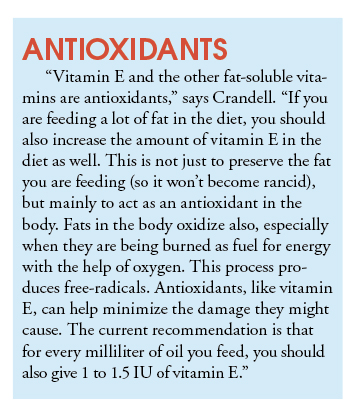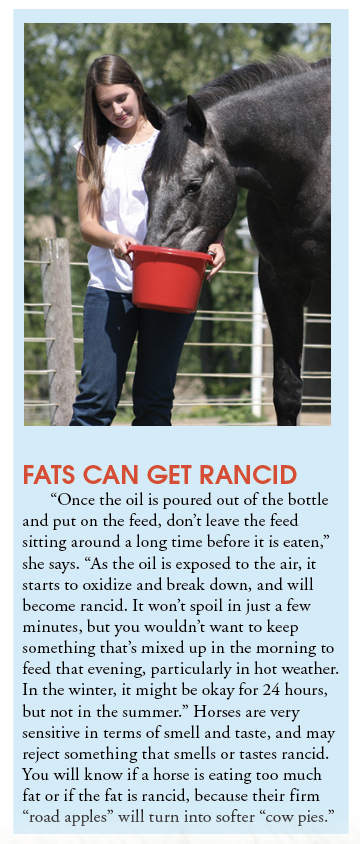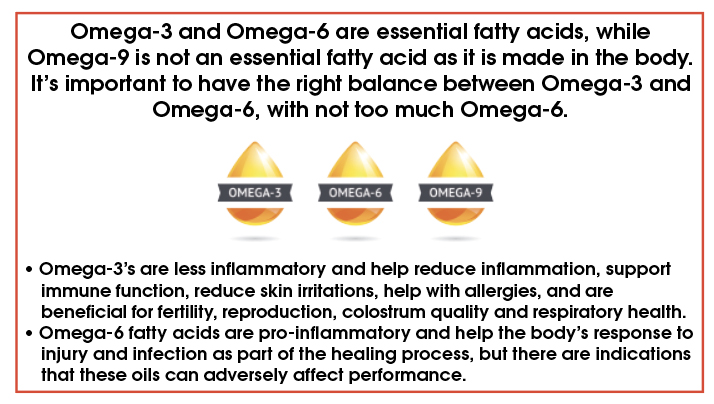
Feeding Fat as a Supplement
Feeding fat has become common practice for helping certain horses that need more total energy in the diet, especially horses in stressful athletic careers, young growing horses, or lactating broodmares, Kathleen Crandell, PhD (Equine Nutritionist, Kentucky Equine Research), says fat is a very concentrated energy source,” A certain amount of oil, for instance, provides 3 times the energy as the same amount of oats, for example,” she says.
Why Feed Fat?
Adding a little fat to the diet can help a thin horse put on weight, or help an athletic horse perform better, providing the extra calories needed for hard work. “Certain types of work benefit more from higher fat diets,” Crandell says. “For example, endurance horses, or any horses that work long and hard, can utilize fat better than the sprinter can. Some people feed fat to improve coat quality, and some feed fat as a ‘calming’ source of energy rather than feeding high levels of grain, which tend to make a horse hyper. Other people feed fat because their horses can’t handle much starch in the diet.
“If a horse needs the extra calories, but you want to lower the amount of starch and sugars, fat can replace most of those calories. You might also feed a little fat to help with vitamin absorption, since the fat-soluble vitamins like A, D, and E, are transported into body cells via fat. Another reason to feed fat would be because of its fatty-acid content; you might want to increase the Omega-3 fatty acids in the diet, for instance.”
Other reasons horsemen add oil to a concentrate feed include using the oil as a way to reduce dustiness along with adding a few more calories. “Feed manufacturers use fat to improve mixing quality; it makes the ingredients slide and mix better without clumping. This is especially beneficial in winter, when any moisture in a feed might freeze and have solid clumps or the whole bag of feed may be hard as a brick. Increasing the oil content can help prevent that problem. For this reason, feed manufacturers commonly change the type of molasses they use in the winter, to one with a higher fat content,” says Crandell. This not only keeps the feed from “bricking” but also adds a few extra calories a horse might need in cold weather.
Types Of Fat
 Regarding general categories, there are vegetable fats and animal fats. “Animal fats include tallow, lard, rendered fat, fish oil, etc.,” she says. “Lard, tallow, and rendered fat are highly saturated (which makes them solid at room temperature) and they are fairly unpalatable for horses. Fish fat, as well as a long list of vegetable fats, are usually oils (liquid at room temperature).
Regarding general categories, there are vegetable fats and animal fats. “Animal fats include tallow, lard, rendered fat, fish oil, etc.,” she says. “Lard, tallow, and rendered fat are highly saturated (which makes them solid at room temperature) and they are fairly unpalatable for horses. Fish fat, as well as a long list of vegetable fats, are usually oils (liquid at room temperature).
“The vegetable oils are nearly 100% fat and usually at least 95% digestible. By contrast, the animal fats are only about 75% digestible for horses. While animal fats are often more economical, they don’t taste as good to horses, have lower digestibility, and tend to become rancid quicker, so most people don’t feed horses animal fats because there are so many other choices,” says Crandell.
The terms fat and oil are interchangeable. Oils are types of fat, and there are basically two types of oils. “One is cold-pressed and the other is solvent-extracted,” she says. “Cold-pressed simply means the oil has been squeezed out of the soybeans, olives, oilseeds, etc. Virgin olive oil is cold-pressed, for instance. For the solvent-extraction process, a chemical is used; the material is first ground up and then combined with something that dissolves the fat out of the solids. Then the residue are removed, and what’s left is oil.
“You get more oil out of the oilseeds with solvent-extraction, but you are also exposing it to the chemicals. By contrast, the cold-pressed material, since the oil is simply squeezed out, leaves a few other nutrients intact within the oil, like vitamin E. There are also some other nutritional factors remaining, so cold-pressed oils are the healthiest. With solvent-extraction you get more oil, but you lose a lot of the other nutrients, including most of the vitamin E. Because the cold-pressed oil contains all these other components, it is more susceptible to rancidity, however, so it may not keep as well. You need to keep it cool and in the dark, and use it up fairly quickly. Don’t buy larger amounts than you can use within a reasonable time. The solvent-extracted oils have longer shelf life,” says Crandell.
Some people use recycled frying oil, like you can get inexpensively from a restaurant or fast-food business. “This is sometimes fed to cows, but not a good thing to feed horses. It may be cheap, or free, but once the oil has been heated repeatedly, there are some chemical changes that make the oil less healthy,” she says.
Options for vegetable oils are many, and include soybean oil, corn oil, sunflower, safflower, peanut, olive oil, cottonseed, linseed, coconut, palm, rice, camelina, hemp, chia, etc. “If you buy vegetable oil in the store, it’s usually a mix of soy and canola oil,” she explains. “Mineral oil is not digested and has no nutritional qualities; it is simply given as a treatment to horses with colic or impaction as a lubricant to help move the contents on through the digestive tract.
“There are some high-fat ingredients and byproducts you can get for horses, rather than just adding oil to a feed. These high-fat products may include ingredients like rice bran, wheat germ, coconut meal, flaxseed, sunflower seed, etc.” she says.
If you are feeding a high-fat product like linseed meal or coconut meal, there often will be some protein as well as fat. “Flax/linseed meal and coconut meal is what’s left after the oil is extracted, but some fat remains. It is different from ground or whole flax, which would contain more fat (about 40%),” she says. Rice bran is just the outer layer of the rice grain, but that’s where all the fat is located; the center of the rice grain is mostly starch.
“Rice oil is often fed because it is high in gamma oryzanol, which is thought of as a muscle builder because it is an antioxidant. It is the main ingredient in body builder supplements, but it is expensive,” she says. Olive oil is also expensive to feed to horses.
A few people feed fish oil (which is actually an animal fat), but it also is expensive. “If a person feeds fish oil, it’s not for the energy, but for the Omega-3 fatty acids. The interesting thing about the Omega-3 fatty acids in fish oil is that they are in a more available form. The Omega-3 fatty acid found in flax is alpha-linolenic acid (ALA) and it is converted by an enzyme into DHA (docosahexaenoic acid) and EPA (eicosapentaenoic acid), which are two anti-inflammatories. The step from ALA to the DHA and EPA is rate-limited by that enzyme, so the conversion rate may be fairly low. If you feed fish oil, however, the form of the fatty acid in the fish oil is already DHA and EPA; it doesn’t have to be converted. It is right there, for the body to use,” says Crandell.
Research on the effects of DHA and EPA in the horse – studies that have been done with fish oil versus flax – has shown more positive results with the fish oil because of the form of the fatty acids. “Even though it sounds contrary to feed fish oil to horses, people in Iceland feed fish (salt herring) to their horses in the wintertime. This is actually the best type of oil if you are feeding for the Omega 3 fatty acids. There are also some marine sources of DHA (from algae), which may also give those same benefits,” she says.
 Omega-3 Fatty Acids VS. Omega-6 Fatty Acids
Omega-3 Fatty Acids VS. Omega-6 Fatty Acids
Some fats have a healthier Omega-3/Omega-6 ratio than others. “If you are feeding just for energy, it doesn’t really matter. Oil is oil, and they all have the same amount of calories,” Crandell explains. “Corn oil is by far the most palatable (in all the studies that have been done), but horses will eat the other oils; they tend to like soy oil, coconut oil, and sunflower oil. Some of the oils like linseed/flaxseed oil, rice oil, hemp oil, etc., won’t be used in large quantities; you would feed them for their other nutritional benefits rather than just energy. You’d generally select those because they are high in Omega-3 fatty acids or have a nice balance of both fatty acids.
“Omega-3 and Omega-6 are both essential fatty acids, which means that the horse can’t produce these in the body and has to get them from the diet,” she says. “The Omega-6 fatty acids are pro-inflammatory. The body needs some inflammatory response to injury, infection, etc., as part of the healing process, but if there is too much of this inflammatory response it can be damaging.
“Omega-3 fatty acids are less inflammatory and they help reduce inflammation. You need a proper balance between these two kinds of fatty acids. Some benefits of Omega-3 fatty acids include support of the immune function, and some of the specific results from supplementation of Omega-3’s are improvement in skin conditions, as it helps reduce reactions to skin irritations. It also helps horses with allergies, and is beneficial for fertility (sperm concentration, motility and viability), reproduction, colostrum quality, passive transfer of antibodies to the foal from colostrum, and respiratory health. Horses with inflammation in the respiratory tract can be helped with Omega-3 supplementation. There are also indications that this can help with inflammation in joints.” Thus, it is very important to have the right balance between the Omega-3 and Omega-6 fatty acids, with not too many Omega-6’s.
In the past, around 25 years ago, most horses were given corn oil as the added fat in their diet. “It’s palatable and easy to feed, and you can buy it in large containers at reasonable price,” she says. “Then, we discovered that corn oil is pretty high in Omega-6 fatty acids. The Omega-6 to Omega-3 ratio in corn oil is 56 parts Omega-6 to 1 part Omega-3.”
Grass is a good source of Omega-3 fatty acids, even though there is not a lot of fat in grass. “What fat there is in grass is higher in Omega-3 than Omega-6,” she says. So, horses on a natural diet of grass get the proper balance for good health.
“We don’t know what the ideal ratio should be in the horse’s body, but current recommendations for humans are about 5 parts Omega-6 to 1 part Omega-3, which is the opposite of what we find in grass,” Crandell says. “Most oils are higher in Omega-6 than Omega-3. Corn oil is 56 to1, while linseed oil is 0.2 to 1, which means it is much higher in Omega-3 than corn oil is. The oils that are really high in Omega-6 are corn, sunflower (632 to 1 Omega-3 – basically no Omega-3’s), peanut oil, and safflower oil (700 to 39). Coconut oil is a little different because it is high in medium-chain fatty acids. If you look at the ratio of Omega-6 to Omega-3, it looks a little bad (almost 15 Omega-6 to 1 Omega-3), but most of the oil consists of medium-chain fatty acids; you wouldn’t be feeding coconut oil for the Omega-3’s. Palm oil is a little higher in Omega-6 (9%) and Omega-3 is only 0.2, so it doesn’t have a very good ratio, either – but it also contains some different fatty acids,” she says.
“Soybean oil and canola have a nice balance. Soy is 7 Omega-6 to 1 Omega-3, so it’s still a little high, but not bad, and this is the most commonly used oil in commercial concentrate feeds. Canola is only 2 to 1, so it is higher in Omega-3 fatty acids than any of the other commonly used oils; it is 11% Omega-3 and 22% Omega-6. If you buy oil to feed for energy and also thinking about the Omega-3s, canola is probably the best one,” says Crandell.
In earlier research looking at corn oil versus rice bran, exercising horses had higher heart rates when fed corn oil. “Whether the Omega-3 fatty acids actually affect performance, we don’t know, but there are some indications that the oils that are really high in Omega-6 fatty acids can adversely affect performance,” she says.
There are a few new fat products on the market for horses, including hemp oil and camelina oil. “The camelina is high in Omega-3 fatty acids (about 39% Omega-3 and only 18% Omega-6). Hemp oil is not as high in Omega-3; it is actually higher in Omega-6 fatty acids than Omega-3, but people tout it because it also has Omega-9. The body can actually make Omega-9 fatty acids, however, so it’s not an essential fatty acid. It’s nice to have it in there, but not really necessary,” she explains.
